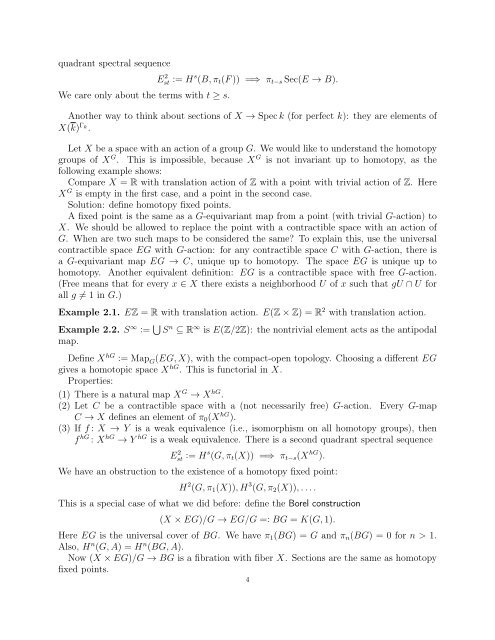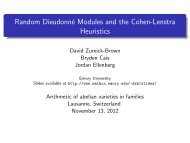alternative lecture notes - Rational points and algebraic cycles
alternative lecture notes - Rational points and algebraic cycles
alternative lecture notes - Rational points and algebraic cycles
Create successful ePaper yourself
Turn your PDF publications into a flip-book with our unique Google optimized e-Paper software.
quadrant spectral sequence<br />
We care only about the terms with t ≥ s.<br />
E 2 st := Hs (B, π t (F )) =⇒ π t−s Sec(E → B).<br />
Another way to think about sections of X → Spec k (for perfect k): they are elements of<br />
X(k) Γ k .<br />
Let X be a space with an action of a group G. We would like to underst<strong>and</strong> the homotopy<br />
groups of X G . This is impossible, because X G is not invariant up to homotopy, as the<br />
following example shows:<br />
Compare X = R with translation action of Z with a point with trivial action of Z. Here<br />
X G is empty in the first case, <strong>and</strong> a point in the second case.<br />
Solution: define homotopy fixed <strong>points</strong>.<br />
A fixed point is the same as a G-equivariant map from a point (with trivial G-action) to<br />
X. We should be allowed to replace the point with a contractible space with an action of<br />
G. When are two such maps to be considered the same? To explain this, use the universal<br />
contractible space EG with G-action: for any contractible space C with G-action, there is<br />
a G-equivariant map EG → C, unique up to homotopy. The space EG is unique up to<br />
homotopy. Another equivalent definition: EG is a contractible space with free G-action.<br />
(Free means that for every x ∈ X there exists a neighborhood U of x such that gU ∩ U for<br />
all g ≠ 1 in G.)<br />
Example 2.1. EZ = R with translation action. E(Z × Z) = R 2 with translation action.<br />
Example 2.2. S ∞ := ⋃ S n ⊆ R ∞ is E(Z/2Z): the nontrivial element acts as the antipodal<br />
map.<br />
Define X hG := Map G (EG, X), with the compact-open topology. Choosing a different EG<br />
gives a homotopic space X hG . This is functorial in X.<br />
Properties:<br />
(1) There is a natural map X G → X hG .<br />
(2) Let C be a contractible space with a (not necessarily free) G-action. Every G-map<br />
C → X defines an element of π 0 (X hG ).<br />
(3) If f : X → Y is a weak equivalence (i.e., isomorphism on all homotopy groups), then<br />
f hG : X hG → Y hG is a weak equivalence. There is a second quadrant spectral sequence<br />
E 2 st := Hs (G, π t (X)) =⇒ π t−s (X hG ).<br />
We have an obstruction to the existence of a homotopy fixed point:<br />
H 2 (G, π 1 (X)), H 3 (G, π 2 (X)), . . . .<br />
This is a special case of what we did before: define the Borel construction<br />
(X × EG)/G → EG/G =: BG = K(G, 1).<br />
Here EG is the universal cover of BG. We have π 1 (BG) = G <strong>and</strong> π n (BG) = 0 for n > 1.<br />
Also, H n (G, A) = H n (BG, A).<br />
Now (X × EG)/G → BG is a fibration with fiber X. Sections are the same as homotopy<br />
fixed <strong>points</strong>.<br />
4



